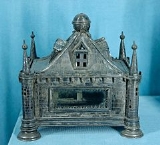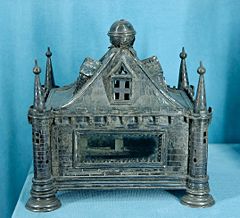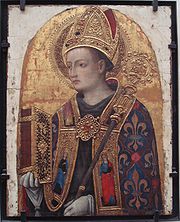
Louis of Toulouse
Encyclopedia
Saint Louis of Toulouse (February 1274 – 19 August 1297) was a cadet of the royal French
house of Anjou
who was made a Catholic bishop
. The California mission
, city and county of San Luis Obispo, California
, are named after him.
He was born in Brignoles
, Provence
, (or in Italy
, at Nocera
, where he spent a part of his early life), the second son of Charles of Anjou
"the Lame" and Maria Arpad of Hungary
, daugther of the King Stephen V of Hungary
. His father was appointed King of Naples, by Pope Clement IV
, the former secretary to Louis IX of France
. The boy was himself a nephew of St Louis and of Mary of Hungary
(her great-aunt being Saint Elizabeth of Hungary), and also the aunt of Saint Louis' mother was Saint Margaret of Hungary
.
When Charles II of Naples was taken prisoner in Italy
, during the war with King Peter III of Aragon
that followed the Sicilian Vespers
, he obtained his own freedom by giving over his three sons as hostages. The boys were taken to Barcelona
—Aragonese territory—where they were placed under the care of Franciscan friars for their education and held for seven years. Though still held in captivity, Louis was made archbishop of Lyon as soon as he reached his majority. When his older brother died in 1295, Louis also became heir to his father's secular titles; however, when he was freed that same year, Louis went to Rome and gave up all claims to his royal inheritance in favor of his brother Robert of Anjou and announced that instead he would take the Franciscan vows of poverty, chastity, and obedience.
On 5 February 1297, Louis was also consecrated Bishop of Toulouse, where his uncle, Alphonse of Toulouse
had until recently been Count, but had died in 1271 leaving no heir. In this ambivalently dynastic and ecclesiastical position, in a territory between Provence and Aquitaine that was essential to Angevin interests, despite the princely standing that had won him this important appointment at the age of about 22, Louis rapidly gained a reputation for serving the poor, feeding the hungry, and ignoring his own needs. After just six months, however, apparently exhausted by his labors, he abandoned the position of Bishop. Six months later, at age 23, he died of a fever, possibly typhoid, at Brignoles
.

 Procedures for his canonization were quickly urged. His case was promoted by Pope Clement V
Procedures for his canonization were quickly urged. His case was promoted by Pope Clement V
in 1307, and he was canonized by John XXII on 7 April 1317. His brother Robert at Naples who owed his crown to Louis commissioned a great altarpiece from Simone Martini
, depicting Louis with that other saint in the family, Louis IX of France
.
The cult of Saint Louis of Toulouse became relevant in the Medieval Hungary. His nephew the King Charles I of Hungary
(1307–1342) exalted his image and veneration, consecrating churches and a monastery in the settlement of Lippa
in his honor, and giving the name of the Saint to his eldest son, which later succeeded him in the throne as Louis I of Hungary (1342–1382).
St Louis of Toulouse was not otherwise widely venerated in the rest of Europe, but the Franciscans embraced him, keeping his day in their calendar and removing his relic
s in 1423 to Valencia
, where he was made patron saint. Thus a Spanish Franciscan mission in Alta California
came to be consecrated to San Luis Obispo de Tolosa
.
He can be recognized in iconography
as a boy bishop, often with a discarded crown by his feet.
A polyphonic
motet
, Flos/Celsa/Quam magnus pontifex, was written in honor of Louis's canonization in 1317. The piece appears anonymously in the Ivrea Codex
and has been attributed by modern scholars to Philippe de Vitry
.
France
The French Republic , The French Republic , The French Republic , (commonly known as France , is a unitary semi-presidential republic in Western Europe with several overseas territories and islands located on other continents and in the Indian, Pacific, and Atlantic oceans. Metropolitan France...
house of Anjou
Capetian House of Anjou
The Capetian House of Anjou, also known as the House of Anjou-Sicily and House of Anjou-Naples, was a royal house and cadet branch of the direct House of Capet. Founded by Charles I of Sicily, a son of Louis VIII of France, the Capetian king first ruled the Kingdom of Sicily during the 13th century...
who was made a Catholic bishop
Bishop (Catholic Church)
In the Catholic Church, a bishop is an ordained minister who holds the fullness of the sacrament of Holy Orders and is responsible for teaching the Catholic faith and ruling the Church....
. The California mission
Mission San Luis Obispo de Tolosa
Mission San Luis Obispo de Tolosa was founded 1772 on the Central Coast of California on a site located halfway between Santa Barbara and Monterey. It was named after Saint Louis of Anjou, the bishop of Toulouse. The Mission church of San Luis Obispo is unusual in its design in that its...
, city and county of San Luis Obispo, California
San Luis Obispo, California
San Luis Obispo is a city in California, located roughly midway between San Francisco and Los Angeles on the Central Coast. Founded in 1772 by Spanish Fr. Junipero Serra, San Luis Obispo is one of California’s oldest communities...
, are named after him.
He was born in Brignoles
Brignoles
Brignoles is a commune in the Var department in the Provence-Alpes-Côte d'Azur region in southern France. It is a sub-prefecture of the department.It was the summer residence of the counts of Provence...
, Provence
Provence
Provence ; Provençal: Provença in classical norm or Prouvènço in Mistralian norm) is a region of south eastern France on the Mediterranean adjacent to Italy. It is part of the administrative région of Provence-Alpes-Côte d'Azur...
, (or in Italy
Italy
Italy , officially the Italian Republic languages]] under the European Charter for Regional or Minority Languages. In each of these, Italy's official name is as follows:;;;;;;;;), is a unitary parliamentary republic in South-Central Europe. To the north it borders France, Switzerland, Austria and...
, at Nocera
Nocera Inferiore
Nocera Inferiore, formerly Nocera dei Pagani, is a town and comune in Campania, Italy, in the province of Salerno, at the foot of Monte Albino, 20 km east-south-east of Naples by rail.-History:...
, where he spent a part of his early life), the second son of Charles of Anjou
Charles II of Naples
Charles II, known as "the Lame" was King of Naples, King of Albania, Prince of Salerno, Prince of Achaea and Count of Anjou.-Biography:...
"the Lame" and Maria Arpad of Hungary
Maria Arpad of Hungary
Mary of Hungary , of the Árpád dynasty, was Queen consort of the Kingdom of Naples. She was a daughter of Stephen V of Hungary and his wife Elizabeth the Cuman.-Family:Mary's mother followed the Shamanist religion, like other Cumans...
, daugther of the King Stephen V of Hungary
Stephen V of Hungary
Stephen V , was King of Hungary from 1270 to 1272.-Early years:...
. His father was appointed King of Naples, by Pope Clement IV
Pope Clement IV
Pope Clement IV , born Gui Faucoi called in later life le Gros , was elected Pope February 5, 1265, in a conclave held at Perugia that took four months, while cardinals argued over whether to call in Charles of Anjou, the youngest brother of Louis IX of France...
, the former secretary to Louis IX of France
Louis IX of France
Louis IX , commonly Saint Louis, was King of France from 1226 until his death. He was also styled Louis II, Count of Artois from 1226 to 1237. Born at Poissy, near Paris, he was an eighth-generation descendant of Hugh Capet, and thus a member of the House of Capet, and the son of Louis VIII and...
. The boy was himself a nephew of St Louis and of Mary of Hungary
Mary of Hungary
Mary of Anjou was queen regnant of Hungary from 1382 until her death in 1395.-Childhood:...
(her great-aunt being Saint Elizabeth of Hungary), and also the aunt of Saint Louis' mother was Saint Margaret of Hungary
Saint Margaret of Hungary
Saint Margaret was a nun and the daughter of King Béla IV and Maria Laskarina. She was the niece of Saint Elizabeth of Hungary and the younger sister of Saint Kinga and Blessed Yolanda.-Early life:...
.
When Charles II of Naples was taken prisoner in Italy
Italy
Italy , officially the Italian Republic languages]] under the European Charter for Regional or Minority Languages. In each of these, Italy's official name is as follows:;;;;;;;;), is a unitary parliamentary republic in South-Central Europe. To the north it borders France, Switzerland, Austria and...
, during the war with King Peter III of Aragon
Peter III of Aragon
Peter the Great was the King of Aragon of Valencia , and Count of Barcelona from 1276 to his death. He conquered Sicily and became its king in 1282. He was one of the greatest of medieval Aragonese monarchs.-Youth and succession:Peter was the eldest son of James I of Aragon and his second wife...
that followed the Sicilian Vespers
Sicilian Vespers
The Sicilian Vespers is the name given to the successful rebellion on the island of Sicily that broke out on the Easter of 1282 against the rule of the French/Angevin king Charles I, who had ruled the Kingdom of Sicily since 1266. Within six weeks three thousand French men and women were slain by...
, he obtained his own freedom by giving over his three sons as hostages. The boys were taken to Barcelona
Barcelona
Barcelona is the second largest city in Spain after Madrid, and the capital of Catalonia, with a population of 1,621,537 within its administrative limits on a land area of...
—Aragonese territory—where they were placed under the care of Franciscan friars for their education and held for seven years. Though still held in captivity, Louis was made archbishop of Lyon as soon as he reached his majority. When his older brother died in 1295, Louis also became heir to his father's secular titles; however, when he was freed that same year, Louis went to Rome and gave up all claims to his royal inheritance in favor of his brother Robert of Anjou and announced that instead he would take the Franciscan vows of poverty, chastity, and obedience.
On 5 February 1297, Louis was also consecrated Bishop of Toulouse, where his uncle, Alphonse of Toulouse
Alphonse of Toulouse
Alfonso or Alphonse was the Count of Poitou from 1225 and Count of Toulouse from 1247.-Life:...
had until recently been Count, but had died in 1271 leaving no heir. In this ambivalently dynastic and ecclesiastical position, in a territory between Provence and Aquitaine that was essential to Angevin interests, despite the princely standing that had won him this important appointment at the age of about 22, Louis rapidly gained a reputation for serving the poor, feeding the hungry, and ignoring his own needs. After just six months, however, apparently exhausted by his labors, he abandoned the position of Bishop. Six months later, at age 23, he died of a fever, possibly typhoid, at Brignoles
Brignoles
Brignoles is a commune in the Var department in the Provence-Alpes-Côte d'Azur region in southern France. It is a sub-prefecture of the department.It was the summer residence of the counts of Provence...
.
Veneration


Pope Clement V
Pope Clement V, born Raymond Bertrand de Got was Pope from 1305 to his death...
in 1307, and he was canonized by John XXII on 7 April 1317. His brother Robert at Naples who owed his crown to Louis commissioned a great altarpiece from Simone Martini
Simone Martini
Simone Martini was an Italian painter born in Siena.He was a major figure in the development of early Italian painting and greatly influenced the development of the International Gothic style....
, depicting Louis with that other saint in the family, Louis IX of France
Louis IX of France
Louis IX , commonly Saint Louis, was King of France from 1226 until his death. He was also styled Louis II, Count of Artois from 1226 to 1237. Born at Poissy, near Paris, he was an eighth-generation descendant of Hugh Capet, and thus a member of the House of Capet, and the son of Louis VIII and...
.
The cult of Saint Louis of Toulouse became relevant in the Medieval Hungary. His nephew the King Charles I of Hungary
Charles I of Hungary
Charles I , also known as Charles Robert , was the first King of Hungary and Croatia of the House of Anjou. He was also descended from the old Hungarian Árpád dynasty. His claim to the throne of Hungary was contested by several pretenders...
(1307–1342) exalted his image and veneration, consecrating churches and a monastery in the settlement of Lippa
Lipova, Arad
Lipova is a town in Romania, Arad County, located in the Banat region of western Transylvania. It is situated at a distance of 34 km from Arad, the county capital, at the contact zone of the Mureș River with the Zarand Mountains, Western Plateau and Lipovei Hills...
in his honor, and giving the name of the Saint to his eldest son, which later succeeded him in the throne as Louis I of Hungary (1342–1382).
St Louis of Toulouse was not otherwise widely venerated in the rest of Europe, but the Franciscans embraced him, keeping his day in their calendar and removing his relic
Relic
In religion, a relic is a part of the body of a saint or a venerated person, or else another type of ancient religious object, carefully preserved for purposes of veneration or as a tangible memorial...
s in 1423 to Valencia
Valencia (city in Spain)
Valencia or València is the capital and most populous city of the autonomous community of Valencia and the third largest city in Spain, with a population of 809,267 in 2010. It is the 15th-most populous municipality in the European Union...
, where he was made patron saint. Thus a Spanish Franciscan mission in Alta California
Alta California
Alta California was a province and territory in the Viceroyalty of New Spain and later a territory and department in independent Mexico. The territory was created in 1769 out of the northern part of the former province of Las Californias, and consisted of the modern American states of California,...
came to be consecrated to San Luis Obispo de Tolosa
Mission San Luis Obispo de Tolosa
Mission San Luis Obispo de Tolosa was founded 1772 on the Central Coast of California on a site located halfway between Santa Barbara and Monterey. It was named after Saint Louis of Anjou, the bishop of Toulouse. The Mission church of San Luis Obispo is unusual in its design in that its...
.
He can be recognized in iconography
Iconography
Iconography is the branch of art history which studies the identification, description, and the interpretation of the content of images. The word iconography literally means "image writing", and comes from the Greek "image" and "to write". A secondary meaning is the painting of icons in the...
as a boy bishop, often with a discarded crown by his feet.
A polyphonic
Polyphony
In music, polyphony is a texture consisting of two or more independent melodic voices, as opposed to music with just one voice or music with one dominant melodic voice accompanied by chords ....
motet
Motet
In classical music, motet is a word that is applied to a number of highly varied choral musical compositions.-Etymology:The name comes either from the Latin movere, or a Latinized version of Old French mot, "word" or "verbal utterance." The Medieval Latin for "motet" is motectum, and the Italian...
, Flos/Celsa/Quam magnus pontifex, was written in honor of Louis's canonization in 1317. The piece appears anonymously in the Ivrea Codex
Ivrea Codex
The Ivrea Codex is a parchment manuscript containing a significant body of 14th century French polyphonic music....
and has been attributed by modern scholars to Philippe de Vitry
Philippe de Vitry
Philippe de Vitry was a French composer, music theorist and poet. He was an accomplished, innovative, and influential composer, and may also have been the author of the Ars Nova treatise...
.
Ancestry
External links
- Catholic Encyclopedia: St Louis of Toulouse
- Amelia Carr, "St Louis of Toulouse"
- Patron Saints: Louis of Toulouse

